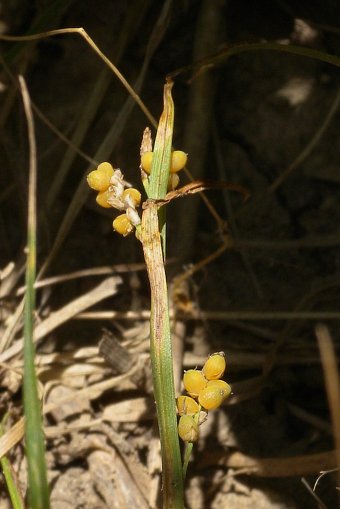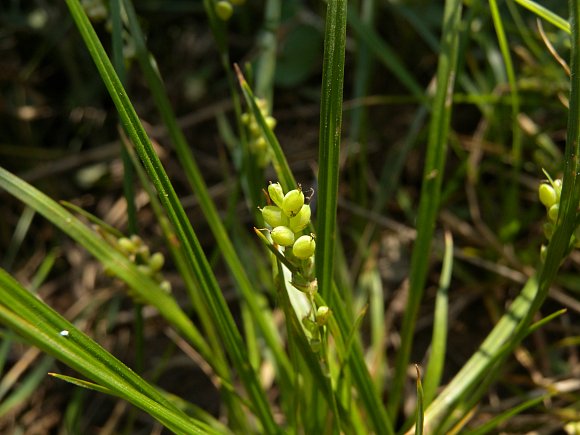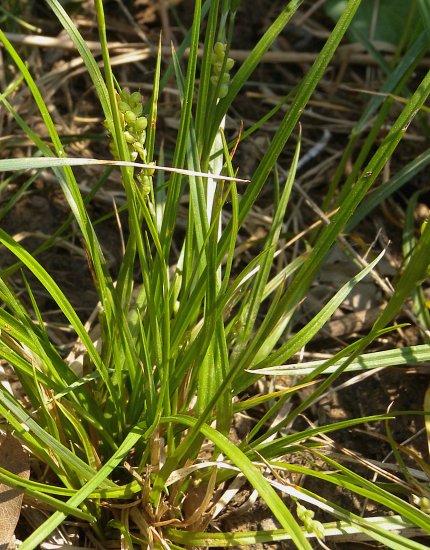
The perigynia are 2.5-3.0 mm. long and about 2.0 mm. across; they are obovoid in shape and glabrous. The perigynia are beakless toward their tops and stipe-like toward their bottoms; along their sides they have faint longitudinal veins. Immature perigynia are pale green, while mature perigynia are golden yellow or orange. However, mature perigynia persist on their spikelets for only a short period of time. The pistillate scales are about 2.0 mm. long and ovate in shape; their tips are usually acute to cuspidate (appearing short-awned). Initially, these scales have green central veins and membranous margins, but they soon become brownish and sometimes detach from their spikelets before the perigynia are mature. The pistillate spikelets have short stiff peduncles; they are normally erect to ascending. Leafy bracts occur at the bases of these spikelets. The lower bracts are rather large and usually overtop the inflorescence, while the upper bracts are significantly shorter. These bracts are similar in appearance to the leaves. The blooming period occurs during late spring, lasting about 1-2 weeks. The florets are cross-pollinated by the wind. Afterwards, the mature perigynia become detached from their spikelets; each perigynium contains a single achene. The achenes are about 1.5 mm. long and a little less across; they are broadly lenticular (lentil-like) in shape and somewhat flattened. The root system is fibrous and short-rhizomatous.

Cultivation: The preference is full or partial sun, wet to moist conditions, rocky or sandy soil that is calcareous, and cool temperatures. This sedge dislikes hot weather and does not compete well with taller ground vegetation on fertile loam. Most growth and development occurs during the spring and early summer.
Range & Habitat: The native Golden Sedge (Carex aurea) is found primarily in NE Illinois, where it is rare (see Distribution Map). This sedge is state-listed as 'endangered.' Illinois lies along its southern range-limit. It is more common in Michigan and other areas further to the north. Habitats include moist sand prairies and meadows, interdunal swales, sandy fens, hillside seeps and springs, and shallow beach pools. This sedge can be found in both disturbed and higher quality habitats that are very sandy or rocky.

Faunal Associations: Various insects feed on the foliage, seeds, and plant juices of wetland sedges (Carex spp.). These species include several aquatic leaf beetles (primarily Plateumaris spp.), the Sedge Billbug (Sphenophorus costicollis), sedge grasshoppers (Stethophyma spp.), many aphids (Thripsaphis spp. & others), several leafhoppers (especially Cosmotettix spp.), the spittlebug Philaenus parallelus, the seed bugs Cymus angustatus and Oedancala dorsalis, the plant bugs Mimoceps insignis and Teratocoris discolor, larvae of the flies Cordilura varipes and Loxocera cylindrica, caterpillars of several skippers (Euphyes spp., Poanes spp., & others), caterpillars of the butterfly Satyrodes eurydice (Eyed Brown), and caterpillars of such moths as the Virginia Ctenucha (Ctenucha virginica), the Tufted Sedge Moth (Hypocoenia inquinata), and the American Ear Moth (Amphipoea americana). Among vertebrate animals, the seeds and spikelets of wetland sedges are an important source of food to many ducks, rails, and granivorous songbirds. The Bird Table lists many of these species. White-Tailed Deer browse on sedges to a limited extent, while muskrats sometimes feed on the roots and young shoots.

Photographic Location: The wildflower garden of the webmaster in Urbana, Illinois.
Comments: The most interesting thing about this sedge are the colorful perigynia (golden yellow to orange) containing the seeds. Unfortunately, they don't persist in this state for very long before falling to the ground. Golden Sedge (Carex aurea) closely resembles Garber's Sedge (Carex garberi), which also occurs in NE Illinois. This latter sedge can be found along the beaches of Lake Michigan. Unlike Golden Sedge, the mature perigynia of Garber's Sedge have a white-mealy appearance and its terminal spikelets are usually gynecandrous (female florets and their perigynia are held above the male florets). Otherwise, they are quite similar to each other.